Characterization of Potential Micrometeorites by Synchrotron Analysis
Abstract
1. Introduction
2. Materials and Methods
2.1. Micrometeorite Collection and Selection
2.2. Micrometeorite Preparation
2.3. Data Collection
2.3.1. X-ray Fluorescence to Determine Elemental Composition
2.3.2. XRF and XANES of Light Elements
2.3.3. X-ray Microdiffraction
3. Results
3.1. X-ray Fluorescence of Transition Metals
3.2. TES Analysis for Light Elements
3.3. Analysis by X-ray Microdiffraction
4. Discussion
5. Implications for Research in High School Science Education
6. Conclusions
Author Contributions
Funding
Acknowledgments
Conflicts of Interest
References
- Genge, M.J.; Engrand, C.; Gounelle, M.; Taylor, S. The classification of micrometeorites. Meteorit. Planet. Sci. 2008, 43, 497–515. [Google Scholar] [CrossRef]
- Suavet, C.; Gattacceca, J.; Rochette, P.; Perchiazzi, N.; Folco, L.; Duprat, J.; Harvey, R.P. Magnetic properties of micrometeorites. J. Geophys. Res. Solid Earth 2009, 114, B4. [Google Scholar] [CrossRef]
- Suttle, M.D.; Folco, L. The extraterrestrial dust flux: Size distribution and mass contribution estimates inferred from the Transantarctic Mountains (TAM) micrometeorite collection. J. Geophys. Res. Planets 2020. [Google Scholar] [CrossRef]
- Maurette, M.; Olinger, C.; Michel-Levy, M.C.; Kurat, G.; Pourchet, M.; Brandstatter, F.; Bourot-Denise, M. A collection of diverse micrometeorites recovered from 100 tonnes of Antarctic blue ice. Nature 1991, 351, 44–47. [Google Scholar] [CrossRef]
- Duprat, J.; Engrand, C.; Maurette, M.; Kurat, G.; Gounelle, M.; Hammer, C. Micrometeorites from central Antarctic snow: The CONCORDIA collection. Adv. Space Res. 2007, 39, 605–611. [Google Scholar] [CrossRef]
- Dobrica, E.; Engrand, C.; Duprat, J.; Gounelle, M. A statistical overview of concordia Antarctic micrometeorites. In Proceedings of the 73rd Annual Meeting of the Meteoritical-Society, New York, NY, USA, 26–30 July 2010. [Google Scholar]
- Taylor, S.; Matrajt, G.; Guan, Y. Fine-grained precursors dominate the micrometeorite flux. Meteorit. Planet. Sci. 2012, 47, 550–564. [Google Scholar] [CrossRef]
- Taylor, S.; Lever, J.H.; Harvey, R.P. Accretion rate of cosmic spherules measured at the South Pole. Nature 1998, 392, 899–903. [Google Scholar] [CrossRef]
- Taylor, S.; Lever, J.H.; Harvey, R.P. Numbers, types, and compositions of an unbiased collection of cosmic spherules. Meteorit. Planet. Sci. 2000, 35, 651–666. [Google Scholar] [CrossRef]
- Brownlee, D.E. Cosmic dust: Building blocks of planets falling from the sky. Elements 2016, 12, 165–170. [Google Scholar] [CrossRef]
- Imae, N.; Taylor, S.; Iwata, N. Micrometeorite precursors: Clues from the mineralogy and petrology of their relict minerals. Geochim. Cosmochim. Acta 2013, 100, 116–157. [Google Scholar] [CrossRef]
- Steele, I.M. Olivine in Antarctic micrometeorites: Comparison with other extraterrestrial olivine. Geochim. Cosmochim. Acta 1992, 56, 2923–2929. [Google Scholar] [CrossRef]
- Beckerling, W.; Bischoff, A. Occurrence and composition of relict minerals in micrometeorites from Greenland and Antarctica—Implications for their origins. Planet. Space Sci. 1993, 43, 435–449. [Google Scholar] [CrossRef]
- Singerling, S.A.; Brearley, A.J. Primary iron sulfides in CM and CR carbonaceous chondrites: Insights into nebular processes. Meteorit. Planet. Sci. 2018, 53, 2078–2106. [Google Scholar] [CrossRef]
- Genge, M.J.; Larsen, J.; Van Ginneken, M.; Suttle, M.D. An urban collection of modern-day large micrometeorites: Evidence for variations in the extraterrestrial dust flux through the Quaternary. Geology 2017, 45, 119–122. [Google Scholar] [CrossRef]
- Larsen, J. The Stardust Project. In Search of Stardust: Amazing Micrometeorites and Their Terrestrial Imposters; Voyageur Press: Minneapolis, MN, USA, 2017. [Google Scholar]
- City Stardust, Micrometeorites in Our Own Backyard. Available online: https://www.bellmuseum.umn.edu/city-stardust/ (accessed on 26 June 2020).
- Berlin Collects Cosmic Dust. Available online: https://www.museumfuernaturkunde.berlin/en/science/berlin-collects-cosmic-dust (accessed on 16 June 2020).
- Blake, M.; McKee, J.; Statom, R.; Qiu, C.; Menapace, F. Evaluating strategies to collect micrometeorites from rainwater for citizen scientists. J. Astron. Earth Sci. Educ. 2018, 5, 151–160. [Google Scholar] [CrossRef]
- Taylor, S.; Jones, K.W.; Herzog, G.H.; Hornig, C.E. Tomography: A window on the role of sulfur in the structure of micrometeorites. Meteorit. Planet. Sci. 2011, 46, 1498–1509. [Google Scholar] [CrossRef]
- Van Maldeghem, F.; Goderis, S.; Laforce, B.; Soens, B.; De Pauw, E.; Suuronen, J.P.; Van Ginneken, M.; Folco, L.; Debaille, V.; Vince, L.; et al. Characterisation of unmelted micrometeorites using synchrotron-based X-ray analysis. In EGU General Assembly Conference Abstracts, Proceedings of the EGU General Assembly 2018, Vienna, Austria, 4–13 April 2018; EGU: Vienna, Austria, 2018; Volume 20, p. 15929. [Google Scholar]
- Dionnet, Z.; Suttle, M.D.; Longobardo, A.; Rotundi, A.; Folco, L.; Corte, V.D.; King, A. X-ray computed tomography: Morphological and porosity characterization of giant Antarctic micrometeorites. Meteorit. Planet. Sci. 2020. [Google Scholar] [CrossRef]
- Google. Long Island, New York. Available online: https://www.google.com/maps/@40.8466814,-72.9634212,9z (accessed on 1 December 2018).
- Noguchi, T.; Imae, N.; Nakamura, T.; Nozaki, W.; Terada, K.; Mori, T.; Fukuoka, T.; Nogami, K.; Ohashi, H.; Nozaki, W.; et al. A consortium study of Antarctic micrometeorites recovered from the Dome Fuji Station. Antarct. Meteor. Res. 2000, 13, 270. [Google Scholar]
- Submicron Resolution X-ray Spectroscopy. Available online: https://www.bnl.gov/ps/beamlines/beamline.php?r=5-ID (accessed on 21 May 2020).
- Li, L.; Yan, H.; Xu, W.; Yu, D.; Heroux, A.; Lee, W.K.; Campbell, S.I.; Chu, Y.S. PyXRF: Python-based X-ray fluorescence analysis package. In X-ray Nanoimaging: Instruments and METHODS III; SPIE: San Diego, CA, USA, 2017; Volume 10389, p. 103890U. [Google Scholar]
- Northrup, P. The TES Beamline (8-BM) at NSLS-II: Tender-energy spatially resolved X-ray absorption spectroscopy and X-ray fluorescence imaging. J. Synchrotron Rad. 2019, 26, 2064–2074. [Google Scholar] [CrossRef] [PubMed]
- Ravel, B.; Newville, M. ATHENA and ARTEMIS: Interactive graphical data analysis using IFEFFIT. Phys. Scr. 2005, 2005, T115. [Google Scholar]
- X-ray Fluorescence Microprobe (XFM). Available online: https://www.bnl.gov/ps/beamlines/beamline.php?r=4-BM (accessed on 21 May 2020).
- Prescher, C.; Prakapenka, V.B. DIOPTAS: A program for reduction of two-dimensional X-ray diffraction data and data exploration. High Press. Res. 2015, 35, 223–230. [Google Scholar] [CrossRef]
- Putz, H.; Brandenburg, K.; GbR, M. Phase Identification from Powder Diffraction CRYSTAL IMPACT; Crystal Impact GbR: Bonn, Germany, 2003. [Google Scholar]
- Downs, R.T.; Hall-Wallace, M. The American mineralogist crystal structure database. Am. Mineral. 2003, 88, 247–250. [Google Scholar]
- Genge, M.J.; Davies, B.; Suttle, M.D.; van Ginneken, M.; Tomkins, A.G. The mineralogy and petrology of I-type cosmic spherules: Implications for their sources, origins and identification in sedimentary rocks. Geochim. Cosmochim. Acta 2017, 218, 167–200. [Google Scholar] [CrossRef]
- Rudraswami, N.G.; Prasad, M.S.; Babu, E.V.; Kumar, T.V. Chemistry and petrology of Fe–Ni beads from different types of cosmic spherules: Implication for precursors. Geochim. Cosmochim. Acta 2014, 145, 139–158. [Google Scholar] [CrossRef]
- Olinger, C.T.; Maurette, M.; Walker, R.M.; Hohenberg, C.M. Neon measurements of individual Greenland sediment particles: Proof of an extraterrestrial origin and comparison with EDX and morphological analyses. Earth Planet. Sci. Lett. 1990, 100, 77–93. [Google Scholar] [CrossRef]
- Prasad, M.S.; Rudraswami, N.G.; De Araujod, A.; Babu, E.V.; Kumar, T.V. Ordinary chondritic micrometeorites from the Indian Ocean. Meteorit. Planet. Sci. 2015, 50, 1013–1031. [Google Scholar] [CrossRef]
- Kaplan, I.R.; Hulston, J.R. The isotopic abundance and content of sulfur in meteorites. Geochim. Cosmochim. Acta 1966, 30, 479–496. [Google Scholar] [CrossRef]
- Van Ginneken, M.; Genge, M.J.; Folco, L.; Harvey, R.P. The weathering of micrometeorites from the Transantarctic Mountains. Geochim. Cosmochim. Acta 2016, 179, 1–31. [Google Scholar] [CrossRef]



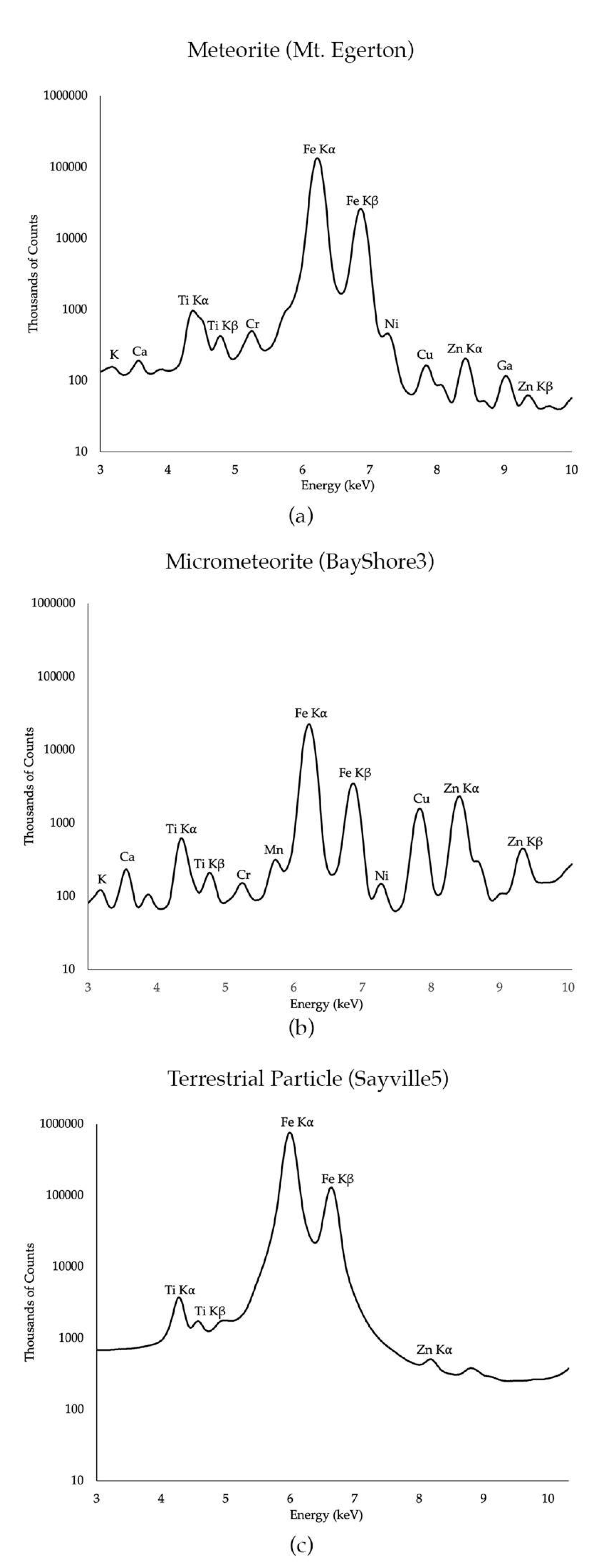

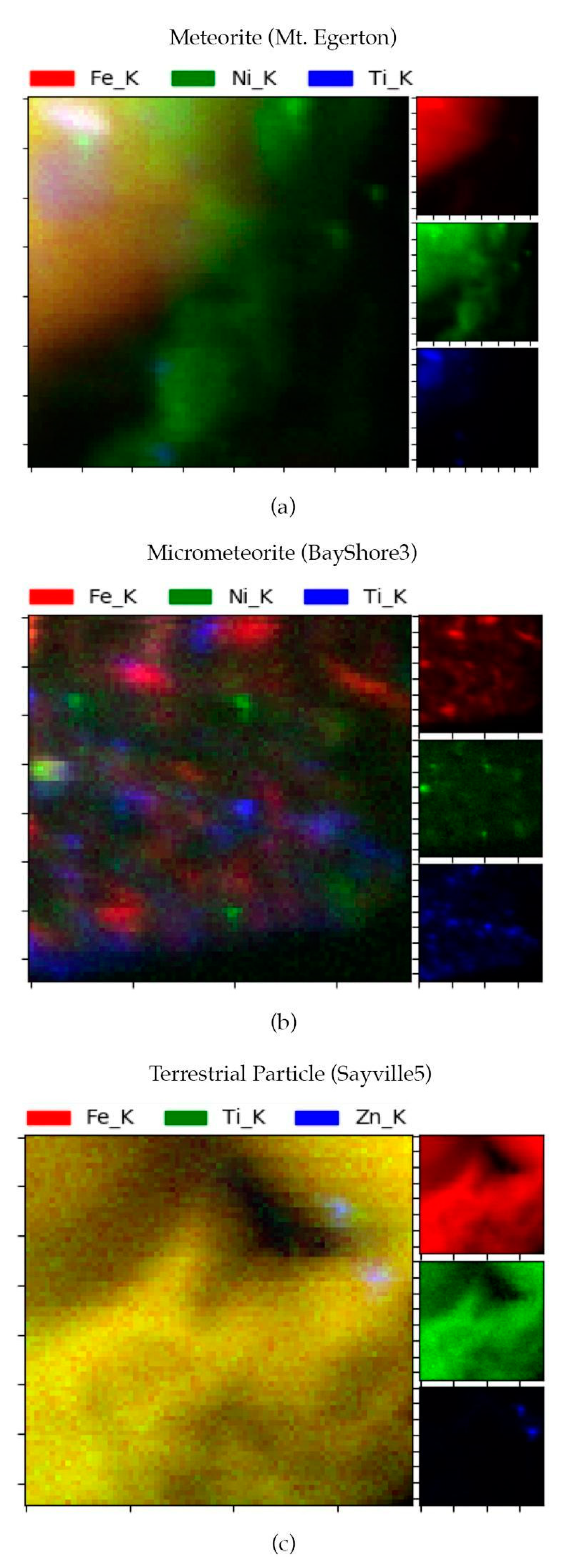
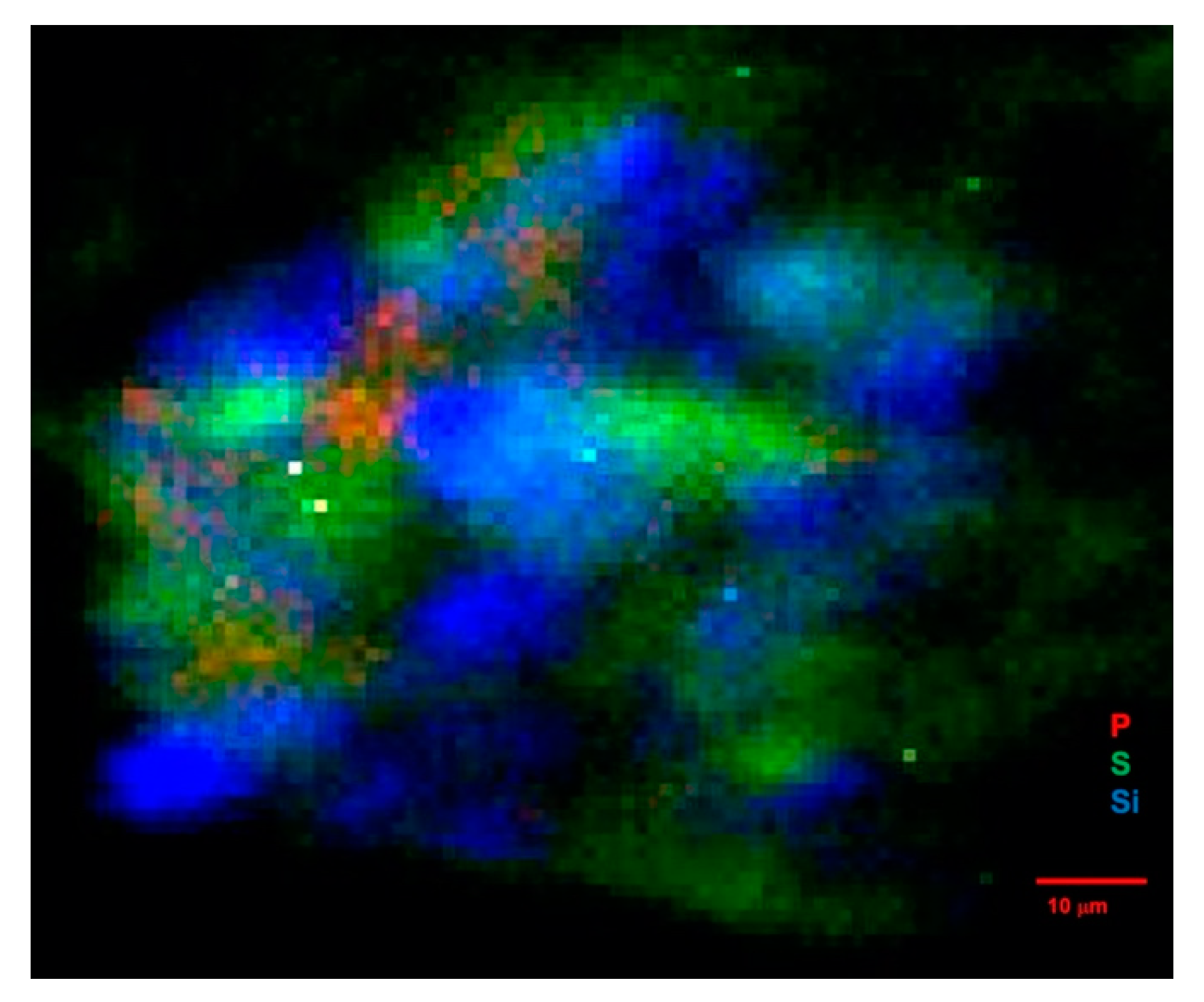
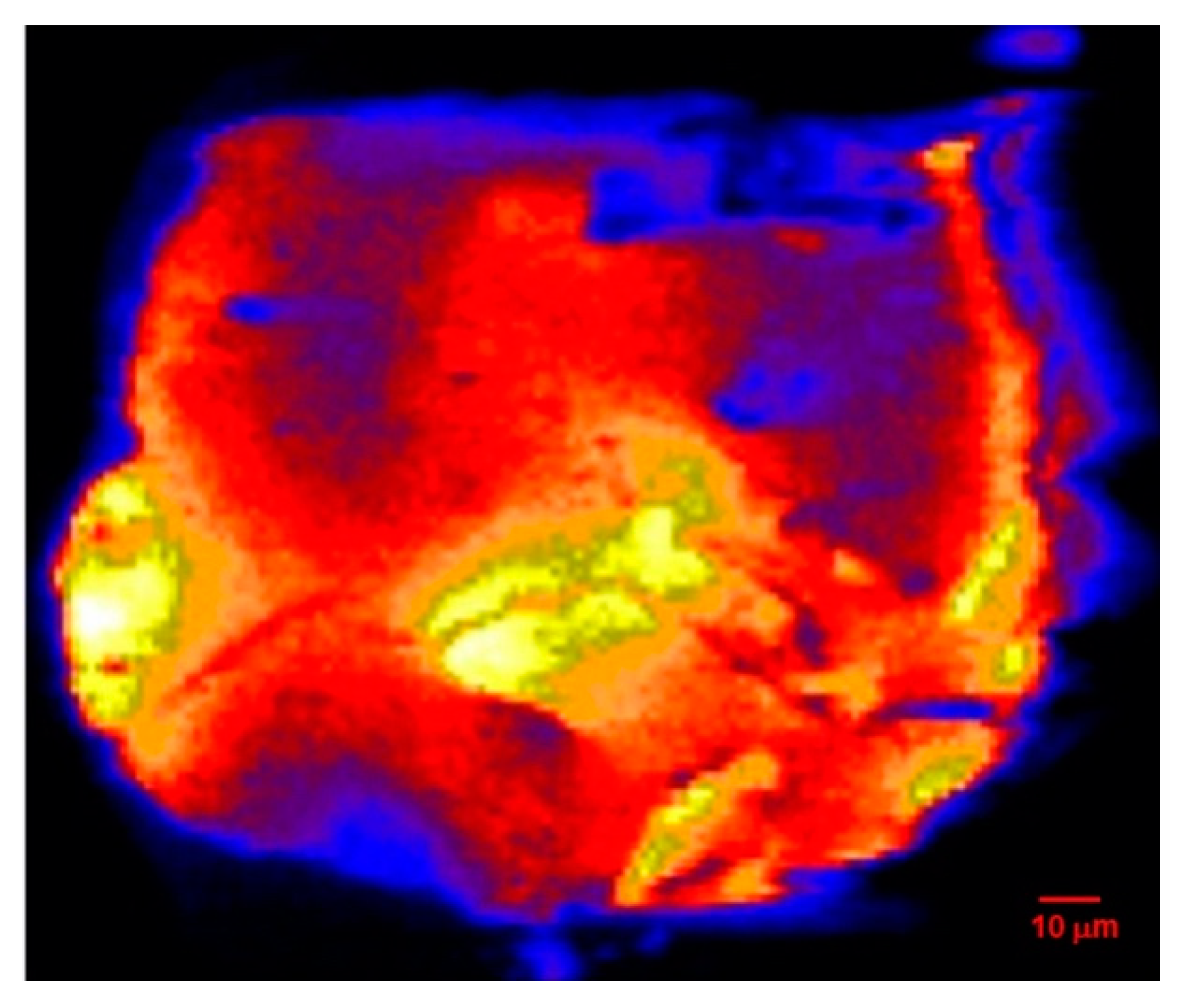
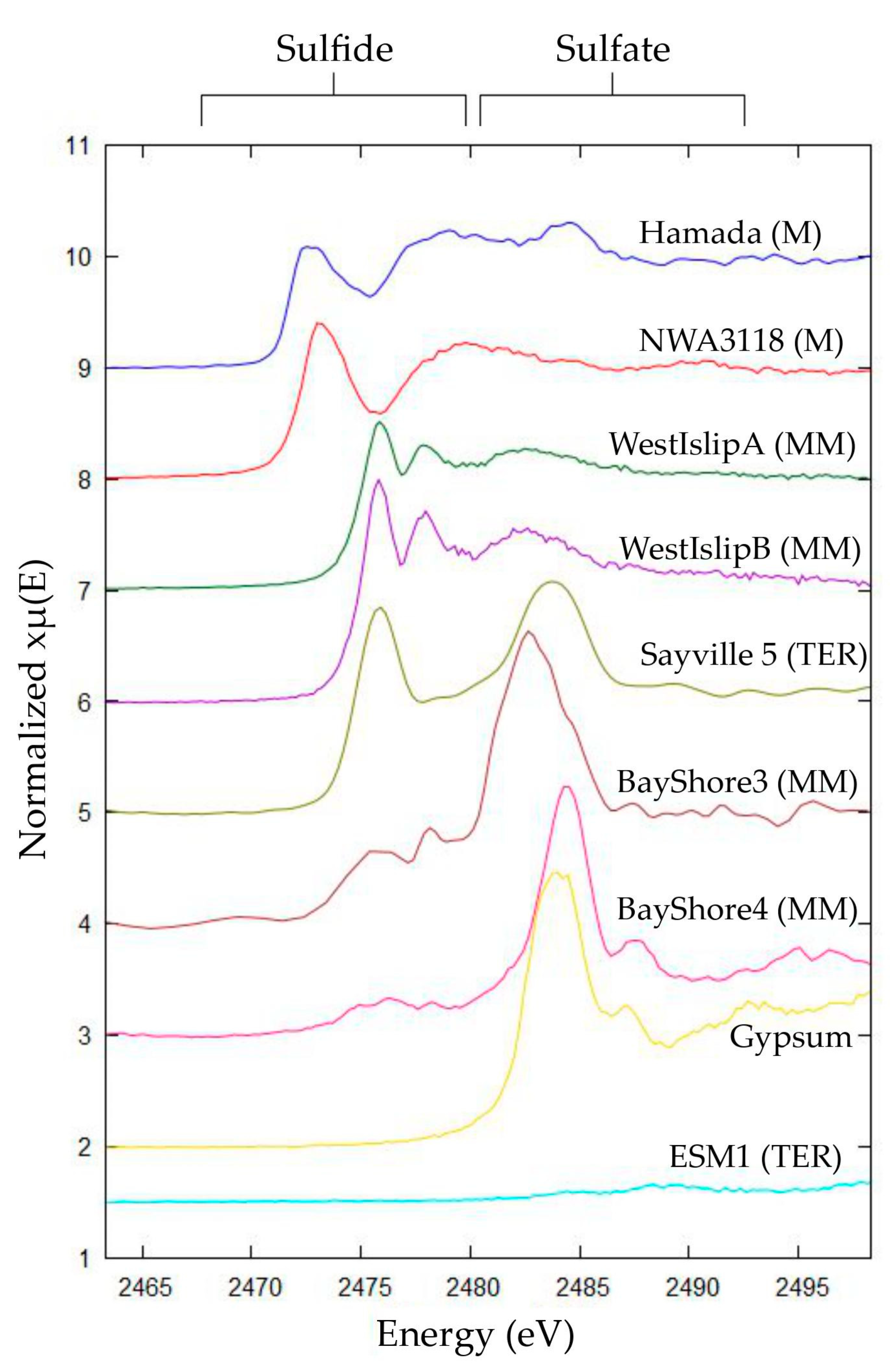
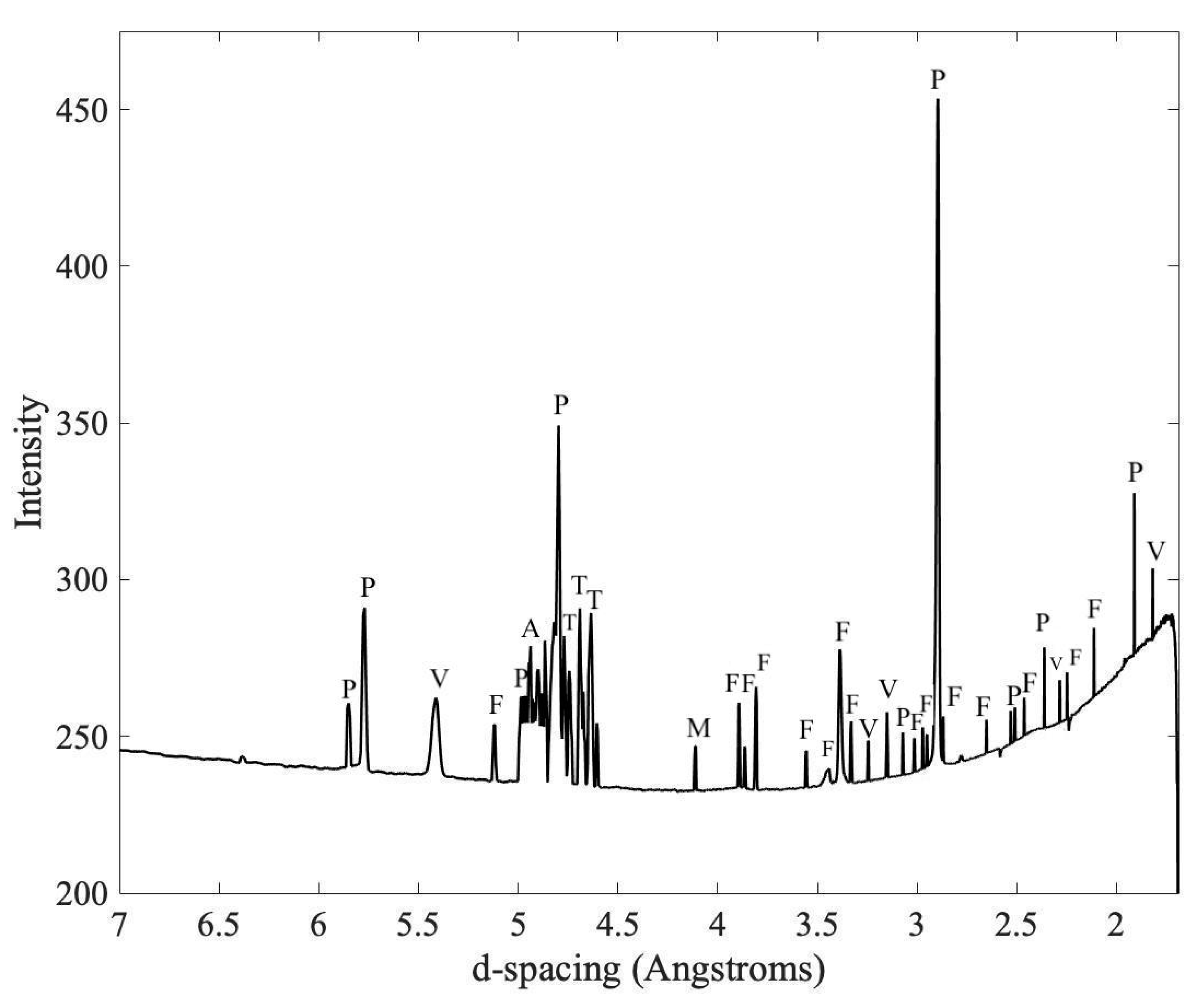
| Sample ID | Location | Class | Ca | Ti | Cr | Mn | Fe | Ni | Cu | Zn | Sulfur Speciation |
|---|---|---|---|---|---|---|---|---|---|---|---|
| Hamada | U | U | M | M | H | N | H | M | N | M | sulfide & sulfate |
| Inkerston | U | U | M | M | M | H | H | N | N | L | unknown |
| Mt. Egerton | WA | A | M | M | M | M | H | M | M | L | unknown |
| Norton County 1 | K | A | M | N | H | H | H | M | M | M | unknown |
| Norton County 2 | K | A | M | M | M | M | H | L | L | L | unknown |
| NWA 3118 | Mo | CC | M | N | M | M | H | M | N | M | sulfide |
| NWA Morocco | U | U | M | M | N | M | H | M | M | M | unknown |
| BigRock1 | U | U | M | M | M | M | H | M | M | H | unknown |
| ESM2 | Ma | T | M | M | M | N | H | M | M | M | absent |
| BayShore3 | BS | CS | M | M | M | M | H | M | M | M | sulfide & sulfate |
| BayShore4 | BS | CS | M | M | M | M | H | M | M | M | sulfide & sulfate |
| Sayville5 | S | T | N | M | N | N | H | N | N | M | minute sulfide |
| Sayville7 | S | T | M | M | L | M | H | N | N | M | unknown |
| Sayville8 | S | T | N | M | N | N | H | N | M | M | unknown |
| WestIslipA | WI | T | L | M | L | N | M | M | L | H | sulfide & sulfate |
| WestIslipB | WI | CS | M | M | M | N | H | M | M | M | sulfide & sulfate |
| Total Samples Collected | Sample Selection Criteria | Total Samples Tested | SRX Characterization Criteria | TES Characterization Criteria | XFM Characterization Criteria | Total Samples Characterized as Cosmic Spherules |
|---|---|---|---|---|---|---|
| 100+ | Magnetic spherical shape particle diameter ~100 μm | 8 | Fe intensity high Ni intensity consistent with meteorites Absence of disqualifying terrestrial components | Sulfide and sulfate presence consistent with meteorite samples | Presence of minerals known to be extraterrestrial including forsterite and pentlandite | 3 |
© 2020 by the authors. Licensee MDPI, Basel, Switzerland. This article is an open access article distributed under the terms and conditions of the Creative Commons Attribution (CC BY) license (http://creativecommons.org/licenses/by/4.0/).
Share and Cite
Esposito, M.; Souhrada, K.; Garland, E.; Kroll, M.; Bolen, R.; Hernandez, V.; Kaczmarek, J.; Meisel, D.; Swiss, A.; Northrup, P.; et al. Characterization of Potential Micrometeorites by Synchrotron Analysis. Geosciences 2020, 10, 275. https://doi.org/10.3390/geosciences10070275
Esposito M, Souhrada K, Garland E, Kroll M, Bolen R, Hernandez V, Kaczmarek J, Meisel D, Swiss A, Northrup P, et al. Characterization of Potential Micrometeorites by Synchrotron Analysis. Geosciences. 2020; 10(7):275. https://doi.org/10.3390/geosciences10070275
Chicago/Turabian StyleEsposito, Madison, Kevin Souhrada, Erin Garland, Mary Kroll, Robert Bolen, Victoria Hernandez, Janet Kaczmarek, David Meisel, Anya Swiss, Paul Northrup, and et al. 2020. "Characterization of Potential Micrometeorites by Synchrotron Analysis" Geosciences 10, no. 7: 275. https://doi.org/10.3390/geosciences10070275
APA StyleEsposito, M., Souhrada, K., Garland, E., Kroll, M., Bolen, R., Hernandez, V., Kaczmarek, J., Meisel, D., Swiss, A., Northrup, P., Stojanoff, V., Thieme, J., & Perez, A. (2020). Characterization of Potential Micrometeorites by Synchrotron Analysis. Geosciences, 10(7), 275. https://doi.org/10.3390/geosciences10070275







